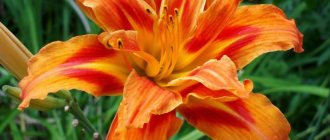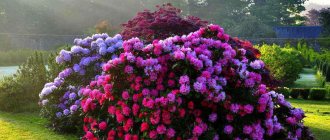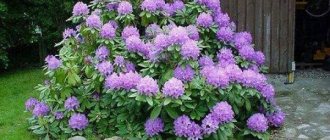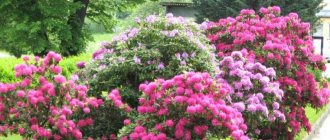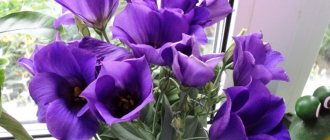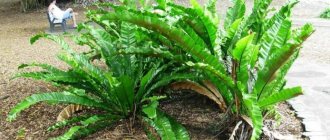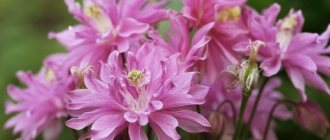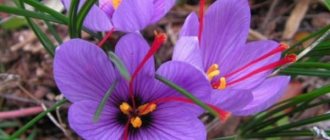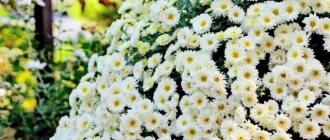Timing for planting rhododendron in spring
First, let's figure out when to plant rhododendrons in the spring in the Moscow region and the middle zone in general. Of course, this can be done in the fall, but before the cold weather there is a high probability that it will not take root or, without getting stronger, will freeze. Therefore, after all, spring is the best time to plant this ornamental shrub.
To plant seedlings, it is better to choose a period when the soil has already receded and warmed up a little, but at the same time still contains a sufficient supply of moisture. High humidity is a prerequisite for good survival. For the middle zone, this is usually April. In principle, rhododendron with a closed root system can be planted throughout the spring and summer, but you should not do this during its flowering, when it is most vulnerable.
Rhododendron in Siberia and the Urals will receive the necessary conditions later, due to a more severe climate. Typically, planting begins in early May.
How to plant rhododendron in spring: main steps
The foundation for a plant's well-being must be laid from the very beginning. To do this, you need to properly organize the following steps:
- choose a place;
- prepare a planting hole;
- lay suitable soil;
- plant correctly.
If everything is done correctly and the rhododendron gets what it “wants,” then caring for it will not differ from caring for most garden crops.
Second transplant to a permanent place
After rooting the seedlings, you need to think about how the rhododendron will be transplanted to a new place, which will become permanent. It is better to do the final transplant in the spring from late April to mid-May.
How to transplant a rhododendron to another place that will become permanent:
- you need to choose a place that will be ideal for the selected plant variety. It is necessary to take into account all factors and nuances: neighbors, lighting;
- The pit is prepared six months before planting. The same mixture is used as a substrate as during the first planting;
- The transplantation procedure is completely identical to the standard algorithm for planting rhododendrons.
Second transplant
When a bush is determined for a permanent place, more attention should be paid to the selection of the site. The remaining stages are not so important for the normal development and growth of the flower.
Choosing a place for rhododendron
Most gardeners face this problem. In a small area, sometimes it can be difficult to find a place that would be completely satisfied with the shrubs. Firstly, rhododendron does not like direct sunlight, especially in the summer heat. To plant it, you need to either choose shaded areas, for example, near some trees, or those where the sun looks only in the morning and evening, but not at noon.
A well-groomed rhododendron blooms especially beautifully
It would seem that the place for rhododendron is on the north side, in the shade of buildings or large trees. But it also does not tolerate cold winds from the north, so if you have chosen such a place, then there must be wind protection - a hedge or a solid fence. In the same way, it must be protected from the prevailing winds in your area. At the same time, you need to take into account that rhododendron needs a constant change of air and it is not worth planting it in all sorts of “nooks and crannies”.
Experienced gardeners recommend choosing the right partners for rhododendron if you plan to plant it near trees. Thus, it is undesirable to place it near spruce, red oak, willow, linden, and birch, since due to the type of their root system the shrub will lose the necessary nutrition.
Rhododendron bush in a garden composition
The best neighbors of rhododendron are:
- pine;
- larch;
- fir;
- juniper.
In addition to the fact that they have different nutritional horizons with the shrubs, the coniferous litter of these trees additionally acidifies the soil, creating the best conditions for rhododendron. In the absence of these conifers, it can be planted near pedunculate oak, plum, pear, apple, ash, and lilac.
Despite all its moisture-loving properties, places with close water or lowlands with poor drainage are contraindicated for rhododendron.
Choice of neighbors and transfer distance
In order for the bushes to grow and develop well, it is necessary to choose the right place with favorable “neighbors”.
Why do rhododendron leaves turn yellow and what to do?
An ideal neighborhood would be to plant next to conifers such as larch, spruce or pine. In the garden plot, apple trees, cherry trees, pears and oaks will be good neighbors.
Important! It is strictly forbidden to place plants next to elms, birches, maples, chestnuts and lindens.
Another aspect to consider when planting is the distance between rhododendrons and their neighbors. Thus, it is necessary to retreat at least one and a half meters from buildings, and at least 2 meters from large trees and shrubs. A distance of 1.5-2 meters should be maintained between the bushes themselves.
Transplant technology step by step
Soil for rhododendron
Rhododendron greatly depends on what kind of soil it gets. First of all, you need to pay special attention to its acidity. Alkaline or even neutral ones do not suit him well. The acidity level should be from 3.5 to 5 pH. If the pH values are higher, it is necessary not only to fill the planting hole with suitable soil, but also to acidify the soil during planting and do this regularly in the future.
Soil for hydrangeas and rhododendrons “Bona Forte”
Rhododendron likes soils that are loose, light, well-drained and breathable. They should be nutritious, with a lot of organic matter. On heavy soils (clays and loams) it develops poorly, blooms poorly and may die.
To fill the holes, use a mixture of pine litter with high-moor peat or soil for hydrangeas and rhododendrons “Bona Forte”. The composition of the finished Bona Forte mixture fully meets the requirements of these plants and has the required acidity.
How to feed the plant
In the process of preparing the substrate, some fertilizers are already added to the soil. But further feeding is not excluded because of this. If you periodically apply fertilizer, the bush will show good results in terms of growth and flowering.
Humus for feeding
Experienced gardeners recommend using special fertilizers for rhododendrons. But you can get by with simpler options. Ordinary humus is ideal. It is important to properly prepare organic matter before use: disinfect, sift.
Important! Potassium fertilizers can be used in small doses, but you need to prepare a solution that is optimal for the flower.
Preparing the planting hole
Rhododendron seedlings have a small, superficial root system. However, since the soil on the site rarely meets the requirements of this heather shrub, the planting hole must be large to accommodate a sufficient amount of soil for further growth. On average, it is made about 70 centimeters in diameter and up to 60 cm in depth. If you plan to plant some plants, the distance between the holes should be at least 1 meter.
It is advisable to place a thick drainage layer (15-20 centimeters) of expanded clay, crushed granite stone, broken ceramics or red brick at the bottom of the pit; it will help remove excess moisture and prevent the roots from rotting during prolonged rains.
Difficulties in growing the plant. Useful tips
The main problems are associated with the low winter hardiness of many species. Most rhododendrons need shelter for the winter and preparations for wintering must be done correctly. Deciduous shrubs with flexible branches are pinned to the ground so that they are completely under the snow. Evergreen species are covered with spruce branches, and sometimes a covering material, such as lutrasil, is pulled over the spruce branches. The shelter is removed in March-April.
Advice ! You should not completely remove the cover from evergreen rhododendrons. It is better to leave some of the spruce branches so that the plant gradually adapts to the sun and does not get burned.
Planting rhododendron
We purchased rhododendron seedlings, chose a place and prepared holes, now all that remains is to plant them correctly.
Granular fertilizer for hydrangeas and rhododendrons “Bona Forte”
The planting hole is filled with ready-made soil so that the root ball of the seedling, when installed in the center, is at the top level with the edge of the hole. It is advisable to add granular fertilizer for hydrangeas and rhododendrons “Bona Forte” to the hole. Thanks to its balanced composition and prolonged action, it will provide the seedling with everything necessary throughout the growing season and improve survival rate.
After this, the next portion of soil is poured around the lump so that the root neck of the seedling must remain uncovered, and then it is lightly compacted.
After planting, the soil must be watered very well; each seedling should receive at least 20 liters of water. Then the pit is mulched with a thick layer of fallen pine needles, peat or sawdust. Mulch delays the evaporation of soil moisture and stabilizes the soil microclimate.
What to feed after planting
3 weeks after planting, the bushes should be fed with complex mineral fertilizers. In specialized stores you can find mixtures intended for rhododendrons. A third of the dose intended for an adult plant will be enough for a new garden resident. Next, the crop is fertilized several times per season.
For this purpose, organic and mineral compounds are used. Proper planting is the key to ensuring that the rhododendron will have a beautiful appearance and develop well. The bush of this crop has a luxurious decorative effect, so it is very important to comply with all the requirements in agricultural technology so that the plant can please you with its beauty as much as possible.
Outdoor care for rhododendron
Despite all its unpretentiousness, rhododendron needs basic garden care. It includes standard procedures:
- watering;
- feeding;
- mulching;
- small trimming.
The unearthly flowers of rhododendron will decorate any area
. We have already said that the Bona Forte fertilizer is well suited not only for planting, but also for periodic feeding. To do this, the granules are scattered over the surface and slightly buried during loosening. Fertilizers for rhododendron in the spring should contain not only standard phosphorus, nitrogen and potassium, but also many microelements. Do not forget that the root system of all rhododendrons is superficial and quite vulnerable, so you need to loosen the tree trunk circle very carefully, without affecting the deep layers of the soil. For the same reason, it is better to remove weeds manually, without using hoes.
Good watering is a prerequisite for the well-being of rhododendrons. The upper layers of soil, which are occupied by the root system, dry out quite quickly. The soil should always be moist, but not soggy. It has already been said that the bush does not like stagnant water almost as much as it does drought. Therefore, the need for watering will need to be monitored visually, since the frequency depends on the general air temperature, the drainage properties of the soil, the phase of plant growth, and the time of year.
Rhododendrons do not always need formative pruning. Bushes of many varieties grow quite compactly. In tall varieties, shoots that are too long are pruned; pruning is also needed if you want to give the bushes a certain shape or increase branching.
Rejuvenating and sanitary pruning should be carried out in early spring, while the bushes have not yet awakened. At this time, old and frozen shoots are cut out, the first at a height of 20 to 40 centimeters from the ground, the second completely. When rejuvenating, it is necessary to leave a few old shoots, which will need to be removed next year, then pruning for rhododendron will not be a shock.
Mulching the soil
A prerequisite is mulching to prevent the soil from drying out.
After flowering, you need to break off the inflorescences so that the plant does not waste its energy on ripening seeds (if they are not needed), but directs them to the formation of new flower buds.
Types and varieties
The plant has multiple varieties. Let's look at some of them that are common in parts of Russia.
Pink rhododendron
Pink rhododendron A deciduous shrub variety native to Canada. Frost-resistant, withstands cold down to -30 degrees. The leaves are ellipsoidal, up to three centimeters in size, covered with villi. The height of the bush ranges from one to three meters.
The inflorescence contains up to 9 flowers. Flowering begins with the appearance of the first leaves in April and lasts two weeks. The plant prefers rocky soil and is preferably planted in groups. Avoid areas with underground groundwater.
Propagated by layering, bending shoots to the ground, and by seeds. If the plant is provided with proper care, it can delight you with lush flowering twice a year.
Rhododendron Katevbinsky "Grandiflorum"
Rhododendron Katevbinsky "Grandiflorum" This type of shrub has a magnificent appearance during flowering. This plant reaches a height of up to 6 meters. The overgrown semicircular dense crown has a diameter of up to two meters. Used in group plantings. Complements landscape design, can be used as a hedge. Loves illuminated places, afraid of drafts.
The bark has a brown tint. Elongated dark green leaves up to 15 cm long and up to 5 cm wide. Above - dark and shiny, below - matte and light with visible dark veins.
Flowers in the form of bells are lilac, white, violet, violet-red. The inflorescence contains up to 20 flowers with a diameter of about 6 cm. The flowering plant presents a grandiose spectacle, capable of decorating the most exquisite landscape from May to June. The fruits are formed in October and have the form of boxes.
The plant is used to decorate fences, paths, and gazebos. With the help of plantings, you can create colorful compositions by combining them with other crops. They look beautiful next to thuja and cypress.
Since the shrub grows well upward, pruning is recommended in the form of pinching individual shoots. The plant is moisture-loving, so in hot weather it is best to provide deep watering.
Rhododendron Helsinki
Helsinki Rhododendron Winter-hardy evergreen variety bred in Finland. This is the most resistant bush to weather changes and the effects of cold. The height of the bush reaches 1.7 m with a crown diameter of 1.5 m. Dark green leaves reach 15 cm in length.
Delicate pink flowers with dark red specks in the upper part of the petal have a funnel shape with a diameter of 7.5 cm. A distinctive feature is the slightly wavy edges of the petals. Flowers are collected in inflorescences with up to 18 flowers. Young plants bloom in early summer (June).
The shade-loving plant can bloom even in the shade of trees and buildings. The bush tolerates frosts down to -40 degrees.
For better flowering, remove faded inflorescences and seed pods. For successful wintering, the plant is watered. Good watering should be provided in hot weather - 12 liters per bush twice a week.
Weeding is done by hand, leaving the weeds next to the bush for mulching. Propagated by cuttings and seeds. Planting seeds does not make it possible to get a flowering bush quickly; flowering begins only in the fifth or sixth year.
From this side cuttings are effective. Flowers appear after a year. The plant reproduces well by layering, ensuring flowering every year.
Planting is carried out in separate groups, I select plants of various colors. To select a composition, combine it with evergreen shrubs that differ in bush height.
The beauty of rhododendron flowers is especially impressive against the background of the dark crown of spruce, cypress, and pine trees. It goes well in composition with creeping crops in rock gardens.
Rhododendron Nova Zembla
Rhododendron Nova Zembla This is a hybrid variety, named after the island of the same name on Novaya Zemlya, pleasing the eye with bright red lush inflorescences. The size of the flowers reaches 10 cm. The inflorescence contains up to 12 bell-shaped flowers.
The ruby color of the petals with brown spots in the center and golden anthers present a magnificent sight. Elongated leathery leaves with a dark green surface and light on the back. The branched trunk is gray in color.
The evergreen shrub is cold-resistant. The bush grows quickly, reaching a height of two meters. Has a spreading crown. Branched trunk of gray color.
A distinctive feature is that it can be grown without shelter for the winter; it overwinters at temperatures of -30 degrees. In particularly harsh winter conditions in the Urals and Siberia, the bush is covered with a protective frame for the winter. Young, immature shrubs also require shelter with the onset of cold weather.
The bush blooms in May–June. The preferred planting location is bright areas. It is better to grow on the northern slopes of the mountains, in the shaded corners of the site. The plant does not like strong winds. Feels good when planted next to pine trees.
The plant looks beautiful in large garden plots, in the garden, and near ponds in the form of group plantings. It is effective when combined with other varieties of evergreen rhododendron, which benefits from the use of contrasting colors. It turns out to be an enchanting spectacle.
The main methods of propagating shrubs are cuttings and layering. Propagation by seeds is not particularly used for evergreen plants, since this method leads to the loss of varietal characteristics.
Treatment of rhododendrons in spring
Treatment of rhododendrons in the spring against various diseases and pests is also important. Among the diseases for this representative of heathers, chlorosis, rust, spotting, rot, including gray rot, bacterial cancer, and mosaic are dangerous. To protect against them, preventive treatments are carried out with various preparations, from Bordeaux mixture to copper sulfate, fungicides.
Treatment of rhododendrons
Rhododendron can be attacked by pests such as:
- weevils;
- spider mites;
- thrips;
- whiteflies;
- false scale insects.
Universal spray against aphids, spider mites and other insects "Bona Forte"
If you are thinking about the best way to treat rhododendron in the open ground in the spring to get rid of all these pests, pay attention to the universal spray against aphids, spider mites and other insects "Bona Forte" " This remedy, thanks to the lambda-cyhalothrin included in its composition, effectively acts on any insects that may threaten the bush, including spider mites - one of the most unpleasant pests.
You can read about the fight against spider mites in the article: “Spider mites on plants: what they look like and control measures.”
By planting a rhododendron in the garden and following all the rules for caring for it, from early spring you will be able to admire the caps of beautiful delicate flowers with a sweet honey aroma.
Difficulties and problems during the transplant process
Typically, difficulties and problems depend on what time of year was chosen for transplantation. If the choice fell on spring, then special attention should be paid to pests. At the moment the leaves bloom, insects may appear and want to feast on the first greens.
After spring planting, you need to carefully monitor the specimen all summer: do not flood or overdry the soil, protect the plant from wind, drafts and other adverse environmental influences. Autumn can be very cold or windy for a specimen that has just changed its location. Sometimes you have to build a shelter for a bush.
Shelter for rhododendron
Note! Other nuances of care will be associated with watering, fertilizing, or an initially incorrectly selected planting site or poor-quality soil. You need to carefully monitor the appearance of the bush, it will tell you the problem.
Different varieties of plants require their own characteristics of transplantation and planting. This mainly concerns the choice of location. Other rules are the same for all varieties. You need to prepare a high-quality substrate and dig a hole, choose the ideal day for planting and carry out all the necessary manipulations so that the rose bush takes root and blooms in the near future.
Correct choice of planting material
Two or four year old rhododendron bushes are best suited for planting. When purchasing, pay attention to the bushiness of the seedling cuttings (the most tenacious ones branch immediately near the root collar), and to its leaves (should be free of spots and swellings). Also, be sure to inspect the roots of the seedling; it is unacceptable for them to have wet spots or knots. The place where you purchase seedlings is also important.
It is best to buy them from experienced gardeners or special nurseries, and it is not advisable to buy them at markets, since their chances are much lower (most sellers simply do not know what varieties and species they sell).
What can you combine rhododendron with in a flower garden?
A group planting of several different varieties of rhododendron with different flowering periods will look and feel amazing. If you want variety, you can plant decorative dwarf conifers nearby, which will provide natural acidification of the soil with their crumbling needles.
Joint planting of rhododendron and hydrangea
You can choose hydrangea as a neighbor. Its paniculate varieties are suitable for deciduous rhododendrons, and tree-like hydrangeas go well with evergreen varieties.
Hydrangeas in the same flower garden with rhododendrons will fill the pause in flowering in the second half of summer, and according to agrotechnical requirements they completely coincide with them. However, when placing them together, you should provide the opportunity to freely approach the hydrangea for annual pruning.
In addition, you can use unpretentious large and small shrubs: elderberry, hazel, chokeberry, shadberry, spirea, stephanandra, broom. Among the herbaceous plants, shade-tolerant ferns, liverwort, and mountain weed are recommended. Perennial phlox, tiarella, and saxifrage will fit perfectly.


